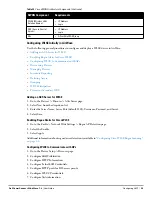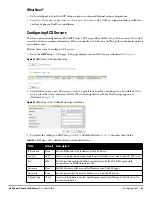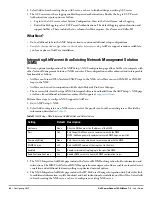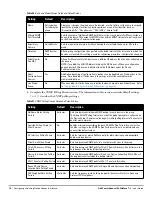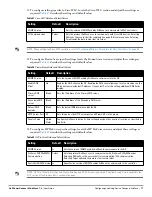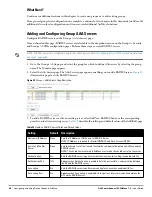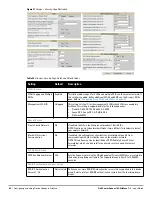
70
| Configuring and Using Device Groups in AirWave
Dell PowerConnect W-AirWave 7.4
| User Guide
PTMP—This page defines settings specific to Proxim MP devices when present. Refer to
“Configuring Group
PTMP Settings” on page
96
.
Proxim Mesh—This page defines mesh AP settings specific to Proxim devices when present. Refer to
“Configuring Proxim Mesh Radio Settings” on page
97
.
MAC ACL—This page defines MAC-specific settings that apply to Proxim, Symbol, and ProCurve 520
devices when present. Refer to
“Configuring Group MAC Access Control Lists” on page
98
.
Firmware—This page manages firmware files for many devices.
“Specifying Minimum Firmware Versions for
APs in a Group” on page
98
.
Compare—This page allows you to compare line item-settings between two device groups. On the Groups >
List page, select Compare Two Groups, select the two groups from the drop-down menus, then select
Compare.
“Comparing Device Groups” on page
99
.
This chapter also provides the following additional procedures for group-level configurations:
“Deleting a Group” on page
100
“Changing Multiple Group Configurations” on page
100
“Modifying Multiple Devices” on page
101
“Using Global Groups for Group Configuration” on page
104
AirWave Groups Overview
Enterprise APs, controllers, routers, and switches have hundreds of variable settings that must be configured
precisely to achieve optimal performance and network security. Configuring all settings on each device
individually is time consuming and error prone. AirWave addresses this challenge by automating the processes of
device configuration and compliance auditing. At the core of this approach is the concept of Device Groups, with
the following functions and benefits:
AirWave
allows certain settings to be managed efficiently at Group-level while others are managed at an
individual device level.
AirWave defines a Group as a subset of the devices on the wireless LAN, ranging in size from one device to
hundreds of devices that share certain common configuration settings.
Groups may be defined based on geography (such as “5th Floor APs”), usage or security policies (such as
“Guest Access APs”), function (such as “Manufacturing APs”), or any other appropriate variable.
Devices within a group may be from different vendors or hardware models. All devices within a Group share
certain basic configuration settings.
Typical group configuration variables include basic settings (SSID, SNMP polling interval, and so forth), security
settings (VLANs, WEP, 802.1x, ACLs, and so forth), and some radio settings (data rates, fragmentation
threshold, RTS threshold, DTIM, preamble, and so forth). When configuration changes are applied at a
group
level
, they are assigned automatically to every device within that group. Such changes must be applied with every
device in Managed mode. Monitor mode is the more common mode.
Individual device settings—such as device name, RF channel selection, RF transmission power, antenna settings,
and so forth—typically should not be managed at a group level and must be individually configured for optimal
performance. Individual AP settings are configured on the APs/Devices > Manage page.
You can create as many different groups as required. Administrators usually establish groups that range in size
from five to 100 wireless devices.
CAUTION: Always review the Audit page before pushing configuration to a device or group.
Содержание PowerConnect W-Airwave
Страница 1: ...Dell PowerConnect W AirWave 7 4 User Guide ...
Страница 106: ...106 Configuring and Using Device Groups in AirWave Dell PowerConnect W AirWave 7 4 User Guide ...
Страница 256: ...256 Creating Running and Emailing Reports Dell PowerConnect W AirWave 7 4 User Guide ...
Страница 310: ...310 Index Dell PowerConnect W AirWave 7 4 User Guide ...




